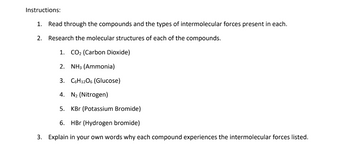
Concept explainers

“Since you have posted a question with multiple sub-parts, we will solve the first three sub-parts for you. To get the remaining sub-part solved please repost the complete question and mention the sub-parts to be solved.”
Introduction to Intermolecular forces
Intermolecular forces refer to the forces between molecules that are strong enough to influence the physical properties of a substance. These forces are electrostatic in nature and can be either attractive or repulsive. The most common types of intermolecular forces are hydrogen bonding, London Dispersion Forces, and dipole-dipole interactions.
Hydrogen bonding occurs when a hydrogen atom, which is covalently bound to a more electronegative atom such as oxygen or nitrogen, forms an electrostatic interaction with another electronegative atom. London dispersion forces are the weakest intermolecular forces and are caused by instantaneous dipoles that are formed when electrons are unevenly distributed in molecules. Dipole-dipole interactions occur between two molecules that have permanent dipoles.
Trending nowThis is a popular solution!
Step by stepSolved in 4 steps with 3 images

Can you answer questiton number three please?
Can you answer questiton number three please?
- The vapor pressure of substance X is 100. mm Hg at 1070.°C. The vapor pressure of substance X increases to 800. mm Hg at 1200. °C. Determine the molar heat of vaporization of substance Xarrow_forwardThe intermolecular forces (IMF) found in the molecule water (h2o) is A dispersion B dipole-dipole C hydrogen bonding D ionicarrow_forwardWhich of the following statements about intermolecular forces are TRUE? Intermolecular forces occur between atoms in different molecules U Intermolecular forces occur between atoms in the same molecule Intermolecular forces are always temporary and weak Intermolecular forces occur between different molecules Intermolecular forces can be temporary, permanent and weak, and permanent and strongarrow_forward
- The boiling points of the halogens increase going from fluorine to iodine. What type of intermolecular forces is responsible for this trend? dipole-dipole hydrogen bonding ion-ion attraction London dispersion forces network covalent forces 1 point For question #5, briefly explain why you chose your answer. This should be 2 sentences at maximum. BIUA A I E E 3 x x, E 12pt Paragraph EO O O OOarrow_forwardWhat intermolecular forces is/are in the following molecule? Br-Brarrow_forwardBased on the expected intermolecular forces, which halogen has the highest boiling point?a) F2b) Cl2c) Br2d) I2arrow_forward
- Using your own knowledge of intermolecular forces, predict the state of the substance below. Explain your answer. *Assume substance is at room temperature. sodium bromide (NaBr)arrow_forwardFrom each pair below (attached image), select the molecule that will display stronger intermolecular dipole-dipole forces in a sample of the pure substance.arrow_forwardWhat is the strongest type of intermolecular force in CHF2Cl is a. ion-ion b. London dispersion c. hydrogen bonding d. dipole-dipolearrow_forward
- Kindly refer to the table below, 1. Which liquid would have the weakest surface tension? 2. Which liquid has the strongest intermolecular force? 3. Which liquid would be the least viscous? Liquid Vapor pressure (kPa) at 20°C X 2.33 Y 5.85 Z 58.96arrow_forwardThe boiling points of the noble gases go in the order: He < Ar < Ne < Kr < Xe, Which of the following statements explains this increase? A. The London (dispersion) forces increase. B. The hydrogen bonding increases. C. The dipole-dipole forces increase. D. The number of nearest neighbors increases.arrow_forwardIntermolecular Forces Present in Substances Intermolecular Substance LEDS Shape Polarity Forces Present 1) CHSOH 2) O3 3) CH3NH 4) 12 5) HFarrow_forward
 ChemistryChemistryISBN:9781305957404Author:Steven S. Zumdahl, Susan A. Zumdahl, Donald J. DeCostePublisher:Cengage Learning
ChemistryChemistryISBN:9781305957404Author:Steven S. Zumdahl, Susan A. Zumdahl, Donald J. DeCostePublisher:Cengage Learning ChemistryChemistryISBN:9781259911156Author:Raymond Chang Dr., Jason Overby ProfessorPublisher:McGraw-Hill Education
ChemistryChemistryISBN:9781259911156Author:Raymond Chang Dr., Jason Overby ProfessorPublisher:McGraw-Hill Education Principles of Instrumental AnalysisChemistryISBN:9781305577213Author:Douglas A. Skoog, F. James Holler, Stanley R. CrouchPublisher:Cengage Learning
Principles of Instrumental AnalysisChemistryISBN:9781305577213Author:Douglas A. Skoog, F. James Holler, Stanley R. CrouchPublisher:Cengage Learning Organic ChemistryChemistryISBN:9780078021558Author:Janice Gorzynski Smith Dr.Publisher:McGraw-Hill Education
Organic ChemistryChemistryISBN:9780078021558Author:Janice Gorzynski Smith Dr.Publisher:McGraw-Hill Education Chemistry: Principles and ReactionsChemistryISBN:9781305079373Author:William L. Masterton, Cecile N. HurleyPublisher:Cengage Learning
Chemistry: Principles and ReactionsChemistryISBN:9781305079373Author:William L. Masterton, Cecile N. HurleyPublisher:Cengage Learning Elementary Principles of Chemical Processes, Bind...ChemistryISBN:9781118431221Author:Richard M. Felder, Ronald W. Rousseau, Lisa G. BullardPublisher:WILEY
Elementary Principles of Chemical Processes, Bind...ChemistryISBN:9781118431221Author:Richard M. Felder, Ronald W. Rousseau, Lisa G. BullardPublisher:WILEY





